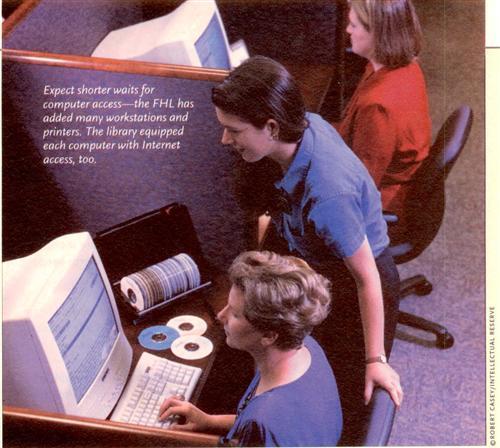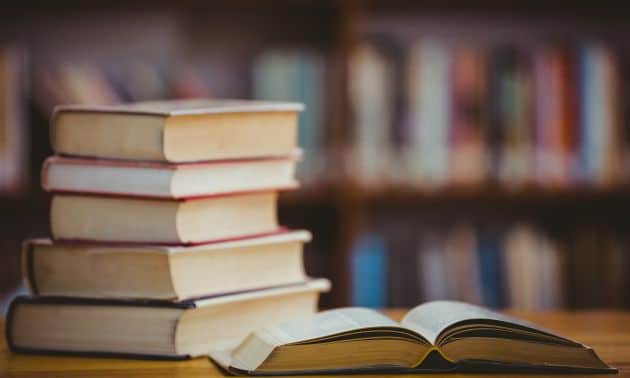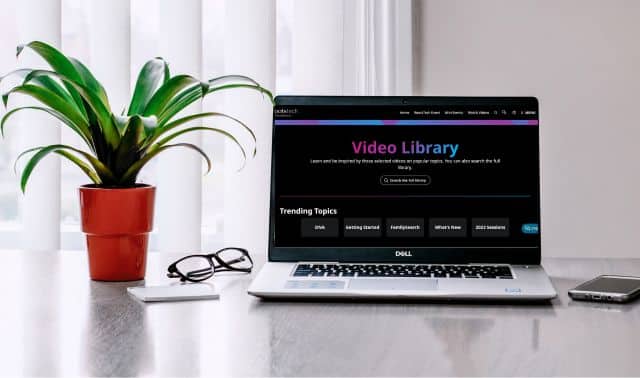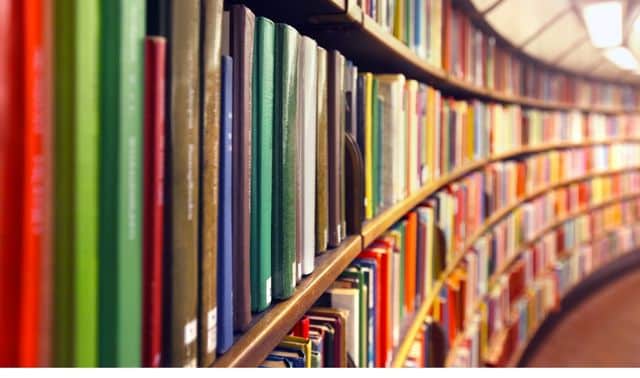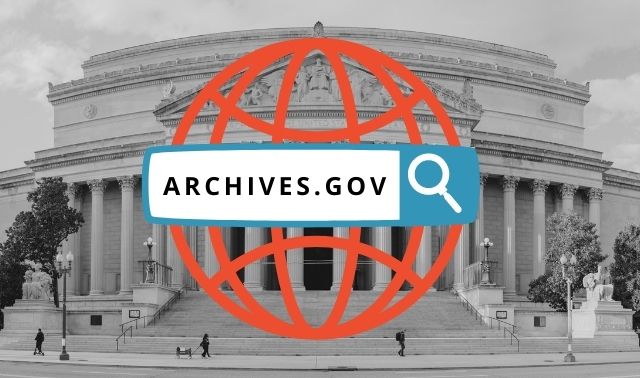Sign up for the Family Tree Newsletter Plus, you’ll receive our 10 Essential Genealogy Research Forms PDF as a special thank you!
Get Your Free Genealogy Forms
"*" indicates required fields
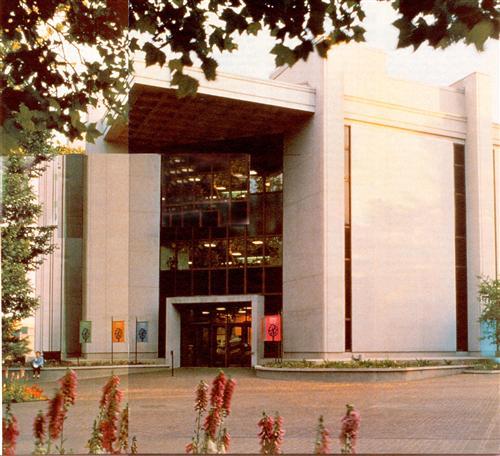 First-time visitors to the Family History Library in Salt Lake City are amazed by the worldwide genealogy collection, the beautiful setting and the conveniences offered in this facility, which is open to all family history researchers. If you’re hoping to make your first trip there — maybe joining the crowds at the Winter Olympics in Salt Lake City in February — you too will probably be amazed at the world’s largest ancestry archive. But if you’ve been to the FHL before, you’ll really love what you see when you return. The library is newly renovated to upgrade capabilities and comfort, take advantage of new resources and research methods, and better meet the needs of the 2,400 patrons who visit on an average day.
First-time visitors to the Family History Library in Salt Lake City are amazed by the worldwide genealogy collection, the beautiful setting and the conveniences offered in this facility, which is open to all family history researchers. If you’re hoping to make your first trip there — maybe joining the crowds at the Winter Olympics in Salt Lake City in February — you too will probably be amazed at the world’s largest ancestry archive. But if you’ve been to the FHL before, you’ll really love what you see when you return. The library is newly renovated to upgrade capabilities and comfort, take advantage of new resources and research methods, and better meet the needs of the 2,400 patrons who visit on an average day.
You now enter the library through new automatic sliding front doors, perhaps after parking in the large, modestly priced public parking lot now available directly behind the library. Once inside you’ll notice floor-to-ceiling changes, including new carpeting throughout and lighting that improves visibility while reducing microfilm-reader glare.computer workstations have been dramatically upgraded. Making copies is faster and simpler thanks to a new copy-card system. The layout of the four research floors has been modified, simplifying access and movement throughout the library. There are now few protruding pillars, no more snakelike rows of equipment, and the facility has a more wide-open and comfortable feel.
Family Tree Magazine‘s August 2000 issue featured a guide to making a trip to the library and the Salt Lake City area. Whether you’ve never been or are planning a return visit, you’ll want to know about the significant changes since then. Here’s what’s new in the FHL and Salt Lake City, from A to Z:
Access
Everyone should appreciate the rearranged layout, which provides greater safety and ease of movement throughout the public floors of the library. (As you “mature” and join those of us who already have trouble seeing, walking or reaching, you’ll appreciate this even more!) Patrons with physical limitations will find lowered sections at the reference counters and easy access to computers, bookcases and other equipment.
CD-ROM Collection
The library has released a series of inexpensive new CD-ROM collections, including the 1880 United States Census and National Index and vital-record index sets for North America, Mexico, the British Isles, Scandinavia and Western Europe. You can order the CD sets from the library’s Web site at <www.familysearch.org>; click on Order/Download Products then Software Products.
The library’s on-site CD-ROM collection includes hundreds of discs from other sources, and was formerly housed in the Automated Resource Center. The FHL is integrating the collection for network access so you can use the CDs at any library computer workstation. You can use CDs for which the library hasn’t received networking permission on the appropriate floor for that geographic location. Just check at the library attendant window.
Computer Workstations & Printers
Many new computer workstations with comfortable, adjustable chairs have been added throughout the library. This means fewer researchers will have to wait for a computer. Each set of two computer workstations shares a laser printer. You pay for printouts with a copy card (see below). If you plan to spend much time using the library computers, don’t forget the many computer workstations nearby in the Joseph Smith Memorial Building (see page 58). The Automated Resource Center on the first floor of the library was eliminated, as many of its resources are being networked for access at all the computer workstations.
Copy Cards!
Have you wished that you didn’t have to lug around coins to make copies in the FHL? Your prayers have been answered. The library has outfitted the computer printers, book copiers and microform copiers for special copy-card use. These simple debit cards speed the copy lines, simplify the process, and keep copy costs down. Book copies and computer printouts are still only a nickel each. Microfilm and microfiche printouts now cost 23 cents each.
To obtain a copy card, simply insert $ 1 in a copy-card dispenser. You receive a card with 40 cents credit. (The card itself costs 60 cents the first time.) You then add value to your card as often as you wish by inserting the card and additional money into the card dispenser. Don’t add more to the card than you expect to use, though, since refunds aren’t issued. You can add up to $50 to a card, but we suggest adding less in case you lose your card or forget it in a copier. (Write your name on your card when you get it.)
Copy Centers
The copy center on the main floor is in a new alcove near its former location. Access to copy centers on other floors has been opened up by removing the walls that separated them from the rest of each library floor.
Doors
Researchers who’ve arrived at the FHL with their arms full of materials have often wished the door would just open. Now it does! The first renovation step was installation of automatic sliding front entry/exit doors. This is a real plus for all the patrons and staff, and especially those with canes, wheelchairs or motorized scooters. The only drawback? They still lock those doors at night!
E-mail in the Library?
The library has added several computer stations at the ends of computer rows where you can go online, access your e-mail account, send messages out and download new e-mail to your laptop computer. If you’ve forgotten where Great-great-aunt Matilda was born, somebody back home can look it up in your flies and e-mail it to you.
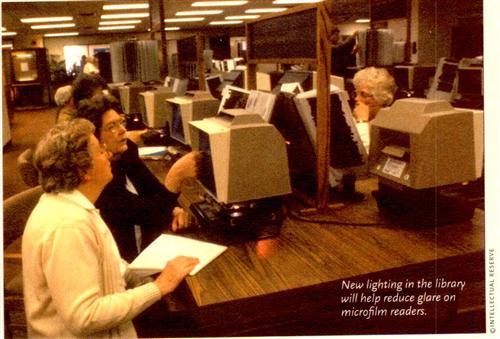
The Family History Center (FHC) system, which provides access to much of the riches of the FHL through branches all over the world, continues to grow. The number of FHCs recently surpassed 3,500. They’re located in more than 80 countries and territories, mostly in Church of Jesus Christ of Latter-day Saints (LDS) meeting houses (although they’re open to people of all faiths at no charge). More centers are making Family-Search Internet available and adding reference material and films to their collections.
Are people using the centers to borrow film and fiche from the FHL? You bet they are, in increasing numbers. On average, more than 100,000 rolls of microfilm per month circulate on loan from Salt Lake City to FHCs.
To locate the FHC nearest you, check the FamilySearch Web site or call (800) 346-6044.
FamilySearch Internet
Improvements aren’t limited to the library building. The FamilySearch Internet site has also been renovated and improved with an easy-to-navigate new format. You can access the FHL catalog here, plus many other electronic databases and a tremendous amount of research assistance. The site keeps growing — check under the site’s News tab for the latest additions. (For tips on how to get the most out of the new FamilySearch, see the December 2001 issue of Family Tree Magazine.)
7 Things That Are Still True
The more things change at the Family History Library, the more some things stay the same. Here are seven things that aren’t new, but are increasingly true about the FHL and worth keeping in mind:
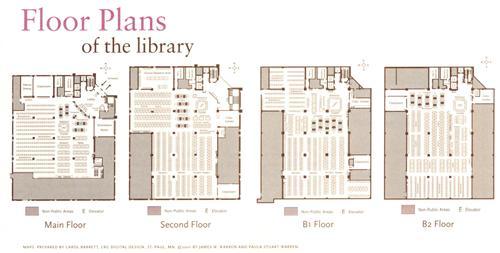
Floor Plans
If you’ve been here before, you’ll immediately notice a difference as you enter each floor of the library. (See the new floor plans below.) In some places, library patrons formerly had to maneuver around pillars. Those pillars couldn’t be eliminated, but cabinets, readers and tables have been rearranged to minimize the maneuvering. New lighting in many areas makes it easier to read cabinet labels while diminishing glare on microfilm readers. Some research tables are in new locations. US and Canadian books are still on the first floor, with US and Canadian microforms on the second floor. You’ll still find British Isles materials on B2. Bl remains the International floor, with materials for Europe, Scandinavia, South America and other countries.
Hotels & Restaurants
There’s good news, too, for out-of-town visitors looking for lodging and dining. A second Marriott hotel opened downtown. And the magnificent new Grand America Hotel, six blocks south of the library, combines Salt Lake’s ultimate hotel accommodations with a spacious convention facility.
New and remodeled restaurants abound in Salt Lake City’s downtown area as well. The Carriage Court restaurant near the library has been converted into a new restaurant, Passages. The Church Office Building Cafeteria, a popular lunch destination for library users, has undergone a complete renovation — the layout changed, but the great food choices and low prices remain intact. The new Orbit Cafe on 200 South features a wide range of food options, late and early hours, a small deli/bakery area and Internet access.
Internet Access
How many times have you been at a library and wished you could check online resources, including the library catalog, at the FamilySearch Web site? At the FHL, this is now as easy as sitting down at any computer workstation. All the FamilySearch Internet features, as well as general access to other Internet sites, are available on every computer. You can quickly move between online information sources or indexes and microfilmed original records as you make new discoveries about ancestral families or localities.
Joseph Smith Memorial Building (JSMB)
Just across Temple Square from the FHL, the JSMB houses the FamilySearch Center. On the first floor of the building, the center has more than 130 computer workstations, padded adjustable chairs, individual laser printers and the complete FamilySearch system of databases. And this area now holds the census material formerly on the fourth floor of the JSMB. That includes a complete set of the 1920 US census and Soundex microfilms, film readers, reader printers and space for the future addition of the 1930 census, which will be released by the National Archives in April (see page 24). The fourth floor now houses all the FHL’s printed family histories, genealogies, biographies and family-association/surname periodicals. (The need to house them here shows how rapidly the library’s book collection has grown.)
Maps
The thousands of maps in the library are an invaluable resource, but in the past you had to ask a library attendant to retrieve a map from locked cabinets. Those cabinets are now unlocked, giving you direct access to the maps, as well as the ability to browse maps for your geographic areas of interest. Once you’re through using a map, place it on the top of the cabinet from which you took it. Library attendants regularly refile them.
Microfilms
Have you been frustrated by some microfilms being stored off-site or housed on a different floor than where you’d expect to find them? Each floor’s new layout and bigger microfilm cabinets have helped remedy some of these former bugaboos, so more films are stored on-site for immediate access. US films previously in a floor B1 overflow area have been reunited with the US film collection on the second floor. And microfilm boxes will have new, easier to read labels with bigger print.
Salt Lake City
The FHL and Temple Square area are accustomed to visitors from around the world. But the Salt Lake City area has blossomed with dramatic new and renovated facilities, businesses and resources as it prepares to host the world, in person and via television, for the Winter Olympic Games in February and the Paralympic Games in March, Those changes are evident everywhere, particularly in the vicinity of the library.
Even before Olympic preparations kicked into high gear, Salt Lake City had become a more significant convention destination, thanks to the opening and subsequent expansion of the new Salt Palace Convention Center. Just a block south of the library, this facility is drawing more and larger conventions to town. When that happens, nearby downtown hotel rooms may be hard to find, but the library may be fairly quiet.
TRAX
Just a half-block south of the library you’ll find one of the TRAX light-rail stations. TRAX began operation in late 1999, providing visitors with north-south access to the city and down the Salt Lake Valley to Sandy, Utah. A second TRAX line has just opened, running east-west on 400 South, with an easy connection to the north-south line. This line adds quick and easy access from the FHL to a wide array of restaurants, hotels, book-stores, other shopping and the University of Utah, which boasts its own tremendous library. Both TRAX and the city buses provide a downtown free-fare zone. TRAX offered another major improvement in 2001 — Sunday service, making it a seven-day-a-week option. (The library is still closed on Sundays.) See <www.utabus.com/schedules/trax.asp> or call (888) RIDE-UTA for TRAX information.
US Census Area
The FHL’s printed census indexes and a copier have been moved to the center of the enlarged US census microfilm area for easy access. The tall tables that hold those census indexes have been shortened to allow you to sit at the tables and to provide wheelchair access.
When to Visit?
From the more than 40 extended trips we’ve made there in the past dozen years, anytime is a good time to be in the library, whether it’s busy or quiet. Peaks and valleys in library usage are much more difficult to predict than in the past. The time between Thanksgiving and Christmas is almost always quiet. The one time we’d suggest you avoid is February 2002, unless you’re prepared or eager to deal with the explosion of people, security and prices that the 2002 Winter Olympic Games will bring to town that month. The medal ceremonies will be held just a block west of the library. Thousands of media are centered in the Salt Palace, one block South. NBC is publicizing this as “The Family Olympics,” and the media are expected to focus enormous attention on the FHL. Once the Olympics are over, pack your suitcase and head to Salt Lake City!
Zurich, Switzerland
Switzerland is just one of more than 40 countries in which FHL microfilming crews are actively filming records today. In many cases, such as the former Soviet republics, the FHL has obtained permission to film records only in recent years. In total, the library has filmed records for more than 110 countries, provinces and territories. In the United States, FHL film crews are at work in a majority of the states. In many areas previously filmed, camera crews are filming record collections and repositories not filmed earlier, as well as extending earlier filming to a later time period.
New material is being added to the Family History Library at the rate of 5,000 rolls of microfilm and 1,000 books every month. The library collection now totals nearly 2.5 million rolls of microfilm, 300,000 books, 745,000 microfiche and 4,500 periodicals.
In short, there’s almost always something new at the FHL.
If you haven’t been to the FHL before, you may be wondering what all the fuss over these changes is about. Trust us veterans — the improvements were much needed. When you do go, you can thank those genealogists who’ve used the library before you, who requested the automatic door, the copy cards and e-mail access. You can also thank the Family History Library director and staff who listened and implemented these improvements. Realize, too, that the library, FamilySearch Internet and the FHCs worldwide are available to anyone, free of charge, through the efforts and generosity of the members and administration of the LDS.
The FHL also deserves our thanks for remaining open throughout the renovation. Temporarily closing would have been far simpler and less expensive. That option was rejected so users from around the world wouldn’t be disappointed.
The point is, the biggest and best genealogical research facility in the world is now better than ever. Make use of these resources and you’ll be amazed what you can learn about your ancestors. We hope we’ll see you soon in Salt Lake City!
Contact Info:
• Family History Library
35 N. West Temple St. Salt Lake City, UT 84150 (801) 240-2331 fax: (801) 240-5551 e-mail: fhl@ldschurch.org <www.familysearch.org>
Library hours: Monday: 7:30 a.m.-5 p.m. Tuesday-Saturday: 7:30 a.m.-10 p.m. Closed Sunday
• Salt Lake Convention & Visitors Bureau
90 S. West Temple St. Salt Lake City, UT 84101 (801) 521-2822 or (800) 541-4955 <www.visitsaltlakecity.com>
From the February 2002 issue of Family Tree Magazine
ADVERTISEMENT

